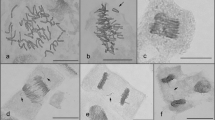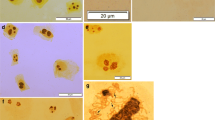Abstract
Seed priming with distilled water (hydropriming) and with micronutrients (nutripriming) can improve the agronomic performance of various crops. Iron (Fe) and Zinc (Zn) are essential micronutrients for plants and humans that have been widely used in wheat biofortification. However, the micronutrients excess can generate cyto- and phytotoxicity affecting the germination, cell division, development and yield. Seed priming is repeated in each generation, and its effects were never studied in the offspring of primed plants. Whether its advantages, cyto- or phytotoxicity are transmitted to the unprimed offspring are unknown. In this work, we used the first generation of seeds (S1) harvested in plants whose seeds (S0) were hydroprimed and nutriprimed with 4 mg L−1 and/or 8 mg L−1 of Fe and/or Zn. We aimed to study their germination, mitotic cell cycle and seven yield-related components in the adult plants, for further comparison with the data achieved in the S0 generation. A germination percentage of 100% was verified in all S1 offspring. Despite the higher values of the percentage of dividing cells with anomalies (%DCA) in S1 relative to S0, a lower number of types of mitotic irregularities, was found, suggesting cytotoxicity attenuation. The S1 surpassed the S0 for all the yield-related components. Our results suggested that the beneficial effects of hydropriming and Fe and/or Zn nutripriming performed in S0 seeds were enhanced in the S1 offspring via seed provisioning and by the epigenetic inheritance of DNA hypomethylation patterns previously detected in the S0 generation.


Similar content being viewed by others
References
Abdelsalam NR, Abdel-Megeed A, Ali HM, Salem MZM, Al-Hayali MFA, Elshikh MS (2018) Genotoxicity effects of silver nanoparticles on wheat (Triticum aestivum L.) root tip cells. Ecotoxicol Environ Saf 155:76–85
Aciksoz SB, Yazici A, Ozturk L, Cakmak I (2011) Biofortification of wheat with iron through soil and foliar application of nitrogen and iron fertilizers. Plant Soil 349:215–225
Afzal I, Rauf S, Basra SMA, Murtaza G (2008) Halopriming improves vigor, metabolism of reserves and ionic contents in wheat seedlings under salt stress. Plant Soil Environ 54:382–388
Ali N, Farooq M, Hassan MA, Arshad MS, Saleem MK, Faran M (2018) Micronutrient seed priming improves stand establishment, grain yield and biofortification of bread wheat. Crop Pasture Sci. https://doi.org/10.1071/CP18042
Bouis HE, Hotz C, McClafferty B, Meenakshi JV, Pfeiffer WH (2011) Biofortification: a new tool to reduce micronutrient malnutrition. Food Nutr Bull 32:S31–S40
Briat J-F, Dubos C, Gaymard F (2015) Iron nutrition, biomass production, and plant product quality. Trends Plant Sci 20:33–40
Cardoso P, Mateus TC, Velu G et al (2018) Localization and distribution of Zn and Fe in grains of biofortified bread wheat lines through micro- and triaxial-X-ray fluorescence spectrometry. Spectrochim Acta Part B Spectrosc 141:70–79
Carvalho A, Leal F, Matos M, Lima-Brito J (2019a) Heat stress tolerance assayed in four wine-producing grapevine varieties using a cytogenetic approach. Cienc Tec Vitivinic 34:61–70
Carvalho A, Reis S, Pavia I, Lima-Brito JE (2019b) Influence of seed priming with iron and/or zinc in the nucleolar activity and protein content of bread wheat. Protoplasma 256:763–775
Carvalho A, Polanco C, Lima-Brito J, Guedes-Pinto H (2010) Differential rRNA genes expression in hexaploid wheat related to NOR methylation. Plant Mol Biol Rep 28:403–412
Carvalho A, Polanco C, Lima-Brito J, Guedes-Pinto H (2013) Differential rRNA genes expression in bread wheat and its inheritance. Genetica 141:319–328
Carvalho A, Leal F, Matos M, Lima-Brito J (2018) Effects of heat stress in the leaf mitotic cell cycle and chromosomes of four wine-producing grapevine varieties. Protoplasma 255:1725–1740
Crisp PA, Ganguly D, Eichten SR, Borevitz JO, Pogson BJ (2016) Reconsidering plant memory: intersections between stress recovery, RNA turnover, and epigenetics. Sci Adv. https://doi.org/10.1126/sciadv.1501340
Farooq M, Basra SMA, Rehman H, Saleem BA (2008) Seed Priming enhances the performance of late sown wheat (Triticum aestivum L.) by improving chilling tolerance. J Agron Crop Sci 194:55–60
Farooq M, Wahid A, Siddique KHM (2012) Micronutrient application through seed treatments: a review. J Soil Sci Plant Nutr 12:125–142
Herman JJ, Sultan SE (2011) Adaptive transgenerational plasticity in plants: case studies, mechanisms, and implications for natural populations. Front Plant Sci 2:102. https://doi.org/10.3389/fpls.2011.00102
Hussain S, Maqsood MA, Rengel Z, Aziz T (2012) Biofortification and estimated human bioavailability of zinc in wheat grains as influenced by methods of zinc application. Plant Soil 361:279–290
Lämke J, Bäurle I (2017) Epigenetic and chromatin-based mechanisms in environmental stress adaptation and stress memory in plants. Genome Biol. https://doi.org/10.1186/s13059-017-1263-6
Lima-Brito J, Guedes-Pinto H, Harrison GE, Heslop-Harrison JS (1996) Chromosome identification and nuclear architecture in triticale × tritordeum F1 hybrids. J Exp Bot 47:583–588
Liu DH, Jiang WS, Wuang C (1996) Effects of Zn2+ on root growth, cell division, and nucleoli of Allium cepa L. J Environ Sci 8:21–27
Mauch-Mani B, Baccelli I, Luna E, Flors V (2017) Defense priming: an adaptative part of induced resistance. Annu Rev Plant Bio 68:485–512
Mondal S, Bose B (2019) Impact of micronutrient seed priming on germination, growth, development, nutritional status and yield aspects of plants. J Plant Nutr 42:2577–2599
Morais DL, Marin-Morales MA (2009) Allium cepa test in environmental monitoring: A review on its application. Mutat Res 682:71–81
Murgia I, Morandini P (2017) Iron deficiency prolongs seed dormancy in Arabidopsis plants. Front Plant Sci. https://doi.org/10.3389/fpls.2017.02077
Oladele EO, Odeigah PGC, Taiwa IA (2013) The genotoxic effect of lead and zinc on bambara groungdnut (Vigna subterranean). Afr J Environ Sci Technol 7:9–13
Paparella S, Araújo SS, Rossi G et al (2015) Seed priming: state of the art and new perspectives. Plant Cell Rep 34:1281–1293
Pekol S, Baloğlu MC, Çelik Altunoğlu Y (2016) Evaluation of genotoxic and cytotoxic effects of environmental stress in wheat species with different ploidy levels. Turk J Biol 40:580–588
Prom-u-thai C, Rerkasem B, Yazici A, Cakmak I (2012) Zinc priming promotes seed germination and seedling vigor of rice. J Plant Nutr Soil Sci 175:482–488
Rajjou L, Duval M, Gallardo K, Catusse J, Bally J, Job C, Job D (2012) Seed germination and vigor. Annu Rev Plant Biol 63:507–533
Rehman A, Farooq M, Ahmad R, Basra SMA (2015) Seed priming with zinc improves the germination and early seedling growth of wheat. Seed Sci Technol 43:262–268
Rehman A, Farooq M, Naveed M, Nawaz A, Shahzad B (2018) Seed priming of Zn with endophytic bacteria improves the productivity and grain biofortification of bread wheat. Eur J Agron 94:98–107
Reis S, Pavia I, Carvalho A, Moutinho-Pereira J, Correia C, Lima-Brito J (2018) Seed priming with iron and zinc in bread wheat: effects in germination, mitosis and grain yield. Protoplasma 255:1179–1194
Shewry R, Sandra J, Hey SJ (2015) The contribution of wheat to human diet and health. Food Energy Secur 4(3):178–202
Singh P (2015) Toxic effect of chromium on genotoxicity and cytotoxicity by use of Allium cepa L. Int J Res Eng App Sci 5:1–10
Sudan J, Raina M, Singh R (2018) Plant epigenetic mechanisms: role in abiotic stress and their generational heritability. 3 Biotech. 8:172
Sundaria N, Singh M, Upreti P, Chauhan RP, Jaiswal JP, Kumar A (2019) Seed priming with iron oxide nanoparticles triggers iron acquisition and biofortification in wheat (Triticum aestivum L.) grains. J Plant Growth Regul 38:122–131
Tabassum T, Farooq M, Ahmad R, Zohaib A, Wahid A (2017) Seed priming and transgenerational drought memory improves tolerance against salt stress in bread wheat. Plant Physiol Biochem 118:362–369
Taranath TC, Patil BN, Santosh TU, Sharath BS (2015) Cytotoxicity of zinc nanoparticles fabricated by Justicia adhatoda L. on root tips of Allium cepa L. - a model approach. Environ Sci Pollut Res 22:8611–8617
Velu G, Ortiz-Monasterio I, Cakmak I, Hao Y, Singh RP (2014) Biofortification strategies to increase grain zinc and iron concentrations in wheat. J Cereal Sci 59:365–372
Venske E, Santos RS, Busanello C, Gustafson P, Oliveira AC (2019) Bread wheat: a role model for plant domestication and breeding. Hereditas. https://doi.org/10.1186/s41065-019-0093-9
Verhoeven KJF, van Gurp TP (2012) Transgenerational effects of stress exposure on offspring phenotypes in apomictic dandelion. PLoS ONE. https://doi.org/10.1371/journal.pone.0038605
Zhang Y-Q, Sun Y-X, Ye Y-L et al (2012) Zinc biofortification of wheat through fertilizer applications in different locations of China. Field Crops Res 125:1–7
Acknowledgements
This work was supported by national funds attributed by the “Fundação para a Ciência e a Tecnologia” (FCT), under the project UIDB/04033/2020 to the CITAB/UTAD research unit. The authors thank the FCT for the project UID/MULTI/04046/2019 attributed to the research unit BioISI. The authors AC and JL-B acknowledge the COST ACTION CA16212, INDEPTH—Impact of nuclear domains on gene expression and plant traits (European Cooperation in Science and Technology). The author AC thanks FCT and UTAD by her contract as a researcher under the scope of D.L. no. 57/2016 of 29 August and Law no. 57/2017 of 19 July.
Funding
This study was supported by national funds attributed by the “Fundação para a Ciência e a Tecnologia” (FCT), under the project UIDB/04033/2020 to CITAB.
Author information
Authors and Affiliations
Contributions
José Lima-Brito and Ana Carvalho were responsible for the study conception and design. Sara Reis obtained the S1 seeds. Miguel Baltazar performed most of the practical work, collected samples and analysed the data with the supervision of José Lima-Brito and Ana Carvalho. Miguel Baltazar wrote the first draft of the manuscript. All authors reviewed the previous versions and approved the final version of the manuscript.
Corresponding author
Ethics declarations
Conflict of interest
The authors declare that they have no conflict of interest.
Ethical approval
This article does not contain any studies with human participants or animals performed by any of the authors.
Additional information
Publisher's Note
Springer Nature remains neutral with regard to jurisdictional claims in published maps and institutional affiliations.
Rights and permissions
About this article
Cite this article
Baltazar, M., Reis, S., Carvalho, A. et al. Cytological and yield-related analyses in offspring of primed bread wheat (Triticum aestivum L.) seeds. Genet Resour Crop Evol 68, 359–370 (2021). https://doi.org/10.1007/s10722-020-00991-8
Received:
Accepted:
Published:
Issue Date:
DOI: https://doi.org/10.1007/s10722-020-00991-8




